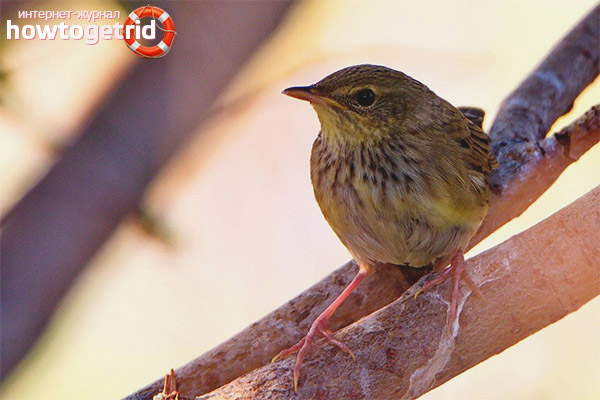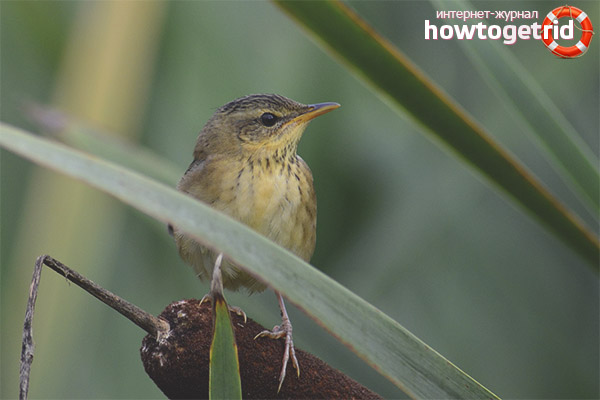The content of the article
A singing cricket is a very cautious bird, but still gives out itself with its unusual singing, iridescent trills.
How to find a cricket singer
This bird belongs to the order of passerine, a subclass of new-minded. Both females and males have a color with brown, brown and olive tones. Such plumage helps them to safely hide from enemies in the undergrowth.
During the mating season, birds have colors with the advantages of brownish and gray in various tones. Only the head is distinguished by the fact that it is indicated by darker colors, and the upper tail is brownish. There are spots on the head and neck. They then move to the front of the back to disappear in the region of the noghvostiya. The chest and back are distinguished by mottling, there are traces of transverse banding along all feathers. In the lower part of the body, the color is light ocher, on the sides there is a slight brownish bloom.
Young birds on the underside of the body are decorated with yellowish bloom, and on the chest and throat are distinguished by longitudinal variegation.
The nape is grayish, and the male can be distinguished by a darker tone. The mandibles of the singing cricket are dark, and the mandibles are yellowish. At the base of the beak in most cases, the setae are not observed. The beak itself is wide, shaped like an awl. Eyebrow ocher light.
The parameters of the bird are:
- body length is small - from 12 to 16 cm;
- weight - from 15 to 20 grams.
Habitats
It nests in Europe and Asia, it can be found at an altitude of 800 - 2100 above sea level, mainly in forest zones, floodplains, choosing thickets of shrubs along the banks of freshwater bodies of water or reeds, high grass, forest edge, especially if the place is different increased dampness.
In winter, sent to the African continent.Usually this flight takes a lot of time, up to 5 months, as birds do not like flying very much. But nevertheless in the middle of April the birds come back.
Secretive life among the undergrowth
Usually singing crickets separate from each other in pairs. For the nest, birds use dry grass, build it in thickets on the ground or at a height of 5-20 centimeters from the ground. But the nest may appear on sedge hummock.
By the end of June, clutch appears. Eggs can be white, but in most cases pinkish, more often dark specks are visible on them. Masonry may consist of 4 eggs, at least 6. Both parents feed the chicks. Fully fledged babies already in July or August. The nesting site is left at the end of August or at the beginning of September.
These birds are very secretive. They are so cautious and small that it is quite difficult for scientists to observe them, especially since during the day crickets prefer to rest and stay awake and sing at night.
Cricket can sing. His iridescent trills with a diverse set of whistles, to which a sharp crackling sound is added, always attract attention.Before the male begins to withdraw his roulades, he finds an open place and sits at the very top of the stem. But it can also fly upward while singing, and, having described the arc, fly down again. His cousin, the taiga cricket, always sings away from the place where the nest is located.
These birds are extremely nimble. But even though they are very mobile, they have a peculiarity: they do not like to take off into the sky, and try to avoid flying. But on the ground they move very willingly, resembling a small mouse. They are very cleverly adapted to run on plants, trees are no exception.
Nutrition
A singing cricket, when it is time for lunch, in search of food, sneaks through dense vegetation on the soil, finding various midges, insects, their larvae and all kinds of invertebrates in the thickets of grass. But the best delicacy for them are spiders. These birds belong to the insectivorous.
Other species

There are other types of crickets. First of all, it is:
- Ordinary. His singing is like the chirping of cricket insects. The mass of his body up to 20 grams. It has an olive-brown back with stripes and a light yellow tummy.
- Spotted. Maximum weight does not exceed 15 grams. Differs in the short sizes of a neck and a tail. The plumage is brown, on the back is black spots, on the tummy - dark specks.
- River. It is considered a large species. The breast and throat are marked by black longitudinal mottles. Light rings are indicated around the eyes. It has a rounded and wide tail at the end. The song of the male is, in fact, an intermittent chant, similar to the sounds made by locusts. Having performed the melody, it rushes to the bushes with a stone.
- Nightingale. Plumage brown with no patterns. White eyebrow barely noticeable. Its melody is the most complex, rich in variety of modulations.
- Taiga. The biggest. His body is lengthened with a stepped and rounded tail. Features a beak - narrow and straight.
Experts usually do not recommend keeping these birds in captivity, as they feel very anxious and die quickly.












To send